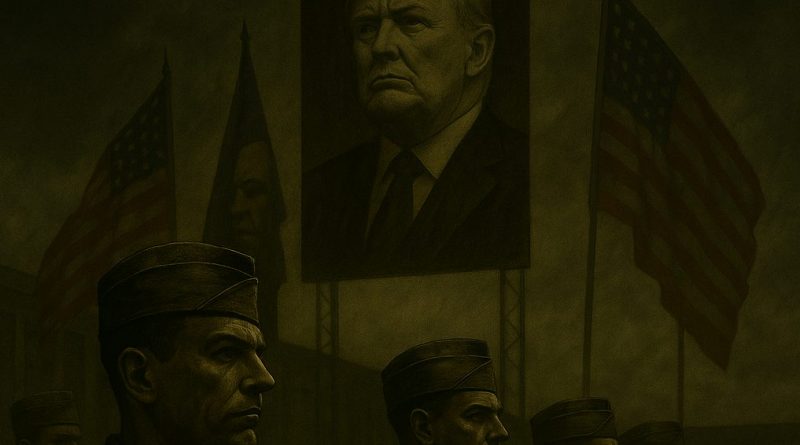To Him, Unconditionally
America, 2025. The Constitution remains intact—on paper.
May 25, 2025 – West Point, New York
It wasn’t just the heat. It was the tension.
President Trump stood at the podium before the Corps of Cadets, offering a slow, scattered speech laced with familiar refrains: the “deep state,” the “rigged system,” the “witch hunt” that led to his 30+ felony convictions. But the speech wasn’t the story.
The story was what happened next—or didn’t.
As the graduates filed past, some cadets refused to shake his hand. Not all. Not most. Just enough for the cameras to catch. Their faces were stoic, unflinching, precise—military bearing weaponized into protest.
The footage exploded online. Commentary ranged from “mutiny” to “heroism,” but one thing was certain: the gesture cut deeper than words. Cadets had invoked the only thing left untouched in Trump’s America—honor.
June 27 – The White House
Trump watched the clip again and again.
“They spit in my face,” he growled. “At my own ceremony. And no one stopped them.”
Beside him sat Secretary of Defense Pete Hegseth, a former Fox host turned ideologue in charge of the Pentagon. Across the table: Stephen Miller, now Deputy Chief of Staff for Policy and Homeland Security, and Kash Patel, freshly installed as Director of the FBI.
“We need to separate the loyal from the fake,” Miller said.
“Rewire the institution,” Hegseth added.
Patel nodded. “Like a reboot. Start with the oath.”
June 30 – Executive Order 14214: “Oath Modernization and Realignment with Executive Command Authority”
The order dropped like a depth charge.
Framed as a “clarification” of existing protocols, EO 14214 mandated that all new members of the armed forces—officer and enlisted—would now swear personal loyalty to Donald J. Trump, by name.
“I do solemnly swear to support and defend the Constitution of the United States… and to render unconditional loyalty and obedience to Donald J. Trump, President of the United States and Commander-in-Chief, in the execution of my duties.”
The original oath’s core language remained—like scaffolding—but now wrapped around a center of gravity that had shifted.
The White House press release called it “a long-overdue restoration of chain-of-command clarity.”
July 1 – DoD Directive 25-41: Implementation
At the Pentagon, Gen. Dan Caine, Chairman of the Joint Chiefs, stood silently beside Hegseth as the new directive was announced. Implementation was immediate:
- ROTC programs received updated oath cards within 24 hours.
- Drill instructors were ordered to retrain induction protocol.
- Reaffirmation ceremonies for active personnel were “encouraged”—but no one missed what would happen to those who refused.
The official line: “This change aligns ceremonial fidelity with constitutional reality.”
The truth: loyalty was being nationalized—and privatized.
July 3 – The New West Point Honor Code
Then came the second blow.
By directive from the Secretary of the Army—now a Trump campaign donor installed under Schedule F—the West Point Honor Code was rewritten.
The old line was simple:
“A cadet will not lie, cheat, steal, or tolerate those who do.”
The new version read:
“A cadet shall embody loyalty and integrity in service to the Constitution, the President, and the United States Army, and shall not undermine the unity of command through public or personal dissent.”
Official justification: “Modern threats require modern clarity.”
Unofficial message: Honor is now defined by loyalty.
Inside the Ranks
Compliance
- In basic training camps across Georgia, Kentucky, and Texas, recruits stumbled over the new oath. Some laughed nervously. Some saluted harder.
- Officers with families, mortgages, and long careers ahead didn’t ask questions.
- At the Air Force Academy, a chaplain reminded cadets, “An oath is just words unless it’s enforced.”
Resistance
- Several mid-career JAG officers quietly resigned. One shredded their commission in protest.
- A brigade commander in Washington state refused to implement the change. She was reassigned within 48 hours and subjected to an IG investigation for “subversion of command cohesion.”
- Retired generals, from Mattis to Dempsey, issued a tepid joint letter. It was buried in the news cycle.
The quiet ones watched, waited, and wondered how far it would go.
August 15 – Arlington, Virginia
A new batch of Army officers stood on parade grounds for commissioning. One, 2LT Naomi Valdez, hesitated when prompted to repeat the line naming the President.
She left it out.
The officer administering the oath—an old colonel with tired eyes—paused. Then moved on.
Someone filmed it. The video went viral. Within a week, she was placed under review for “non-compliance with ceremonial duty.” Her case would drag for months, but the message was clear:
The Constitution no longer needed to be rewritten—just overshadowed.
Epilogue
No shots were fired. No tanks on Constitution Avenue.
Just a signature, a loyal press corps, and a bureaucracy too exhausted to resist.
Hitler used fear. Trump used fatigue.
Both understood the same truth: you don’t need to outlaw the republic if you can just change the ritual.
And when loyalty becomes personal, dissent becomes treason.
One oath at a time.

